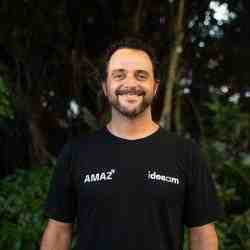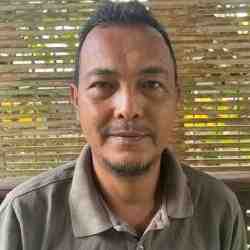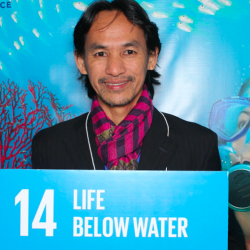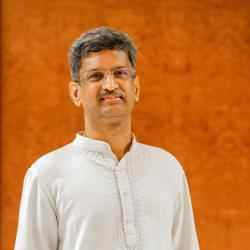Introducción
Asim Sarode envisions a “social-legal system” changing the power equations for victims and witnesses by building legal bridges to empathy and justice.
La idea nueva
Through grassroots victim support and witness protection, Asim is setting a new legal stage to benefit vulnerable populations, speedy resolution of cases under trial, and higher conviction rates. According to Asim, “Every law is a social legislation and needs to be interpreted socially.” Through his work with the Sahayog Trust, Asim is defining the answer to the critical question of who interprets the law and how to empower the most vulnerable groups to access justice.
Asim is creating a new area of judicial responsibility through his Victim and Witness Support Program. To enhance the impact of his concept, he is working towards building a cadre of ‘social lawyers’ and paralegals. This group will work towards sensitizing the judiciary and the police to improve access to justice for vulnerable populations, interaction with victims/witnesses, and legal guidance and training in court procedures. This group will help to bridge the gap between the community and the judicial system thereby strengthening access to justice and making the system people oriented.
Asim connects victims to the judicial system in four ways. He builds knowledge about the judicial system among victims and witnesses of crimes, especially those from marginalized populations. He seeks to humanize the judicial system by building empathy among individuals in the enforcement arm of the judicial system—police, lawyers, and judges. He sets up support systems outside the legal framework by working with the families and communities of victims and witnesses. He generates a larger public debate about access to justice through his work with the media.
Through this program, Asim is changing the prevalent top-down power equation, ensuring that witnesses and victims are treated with respect and empathy, eventually becoming ambassadors of an effective, humane judicial system. He is changing the texture of the legal system by locating the entry point of his work with the lower courts (at district or village level), which is the first—and sometimes only—point of contact for vulnerable populations, and the space with the least existing socio-legal interventions or innovations in India.
El problema
Despite the high incidence of crime in India, there is a low rate of conviction, due in part to the fact that India does not have a comprehensive witness protection program to safeguard witnesses in crucial cases. For cases involving riots and terrorism, the acquittal rate is greater than 90 percent.
The gap in India’s legal system is especially apparent when vulnerable groups seek access to justice. This includes women who are victims of domestic and/or sexual violence, children, and those who are vulnerable to communal violence or under threat of intimidation from organized crime or terrorism. The two key problems—lack of faith in legal and judicial systems and low rates of convictions—are interconnected.
The trial of people accused of mass killings in Gujarat in 2002 descended into a farce after witnesses changed their testimonies due to a campaign of intimidation by state authorities and powerful nationalist groups. There has not been a single conviction in riot cases pending in court since 1984, following former Prime Minister Indira Gandhi’s assassination. In both instances, victims and witnesses giving testimony were mainly from marginalized communities.
A witness protection program is critical not only in riot cases, but also in combating organized crime. Protection of witnesses is very important in the investigation and prosecution of organized crime as witnesses are subject to intimidation by the accused, many of whom are involved in nefarious activities like arms and drugs smuggling, human trafficking, terrorism, and money laundering. Complacency is dangerous as criminals feed off of the laid-back approach of law-enforcement agencies to justice. Only the fear of stringent legal action can act as a check. This requires an effective witness protection program involving all the three concerned agencies—the police, government and judiciary.
In most parts of the country, witnesses bringing cases against rich and powerful people make a mockery of the law, human rights, and democracy. Very often witnesses become untraceable or are simply eliminated. A widely reported case tells the story of two whistle-blowers who reported corruption and were murdered. After pressure from activists, a Draft Witness Protection Bill was submitted to Parliament in 2005—the Bill continues to gather dust.
For witnesses, victims, and their loved ones, the legal system in place spans the police, lawyers, and the judiciary. While the onus of protecting witnesses currently lies within the police force, widespread corruption and bribery mean that there is little faith in their effectiveness. The police in many areas work together with corrupt judicial officers and criminals to intimidate and murder with impunity using “crossfire” encounter killings and mob attacks on persons and property. The country’s enormous bureaucracy remains largely inert, and countless judicial reform committees and commissions ignore witness protection. The systems fail to realize that the witnesses are helping in the process of delivering justice. Today a common man who is a witness to the crime is apprehensive of helping the police and court because of the attitude of these systems of treating a witness like an accused.
The judicial system is seen as unapproachable and the processes to access legal systems are not people-friendly. From the time a victim reports a crime to a police station to when s/he joins the proceedings in a court of law, witnesses and victims are given little respect or importance and are often bullied and belittled. Access to justice is even tougher for marginalized groups, who may not have adequate information, familiarity, or comfort to negotiate legalese and the power dynamics between those who seek justice and those who are mandated to deliver it.
Poor and/or rural rape victims represented by Public Prosecutors are often humiliated with intrusive, demeaning questions and are not aware of their right to object to such treatment. This culture of not asking questions or demanding rights pervades victims’ support systems. Families and communities are worried about risking their safety and exposing themselves to increasingly sensationalized media reports in return for a lengthy, tortuous legal process from a system in which they have limited understanding or confidence. Defense lawyers do not represent victims of crimes as they think it is the domain of the Public Prosecutor. Most of the time the Prosecutor does not look at the crime with a socio-legal perspective and hence is unable to put up the case very strongly in the favour of the victim. Asim is working to change these equations and break the trend by representing the victims along with the Public Prosecutor so as to ensure a fair and just trail.
In a highly stratified society skewed towards class, caste, community, and gender power, the pressure to speak falsely or the temptation to leave midway and turn ‘hostile’ is significant. In cases where the witness is also the aggrieved party or victim of the criminal act in question, they face dual risks—reconciling with their past trauma and a constant fear of inviting additional danger to themselves and their loved ones. In these situations, witness protection programs can act as the much needed support system.
Very often, when the accused is released on bail, one of the conditions imposed by the court is that s/he shall not tamper with evidence, or approach the witnesses. This is not as a provision for to protect the witnesses, but to ensure a fair trial. Judges hold in-camera trials to ensure deposition by witnesses without any fear or embarrassment. Recently the Supreme Court permitted recording of evidence by video-conferencing. All these are inadequate without specific legal provision in state policy to guarantee protective measures to victims before and after the trial.
La estrategia
Recently, a number of high-profile human rights cases at both the state and national levels revealed that witnesses turned hostile. Asim is the only person in the country focusing on the lower courts—at the district, taluka and village level- a space usually ignored in judicial reforms and socio-legal work. By creating a cadre of “people’s lawyers” to fill legal intervention gaps, Asim’s work addresses the clear need for legal and moral support among victims and witnesses. In the lower courts, Asim believes in “advocacy after authority”, which means building a volume of successful case studies where direct legal intervention has led to victim and/or witness protection, and uses this legal precedent to argue for changes within all levels of the judiciary.
The most critical component of his strategy is based on behavior change among key groups of people. For people who work in the judicial branch, Asim holds regular trainings for young law students on building rapport with witnesses and implementing his model. Asim believes every lawyer works as a professional and not always “for the people.” Getting students interested in his approach is the first step towards transforming attitudes and building up a cadre of socially-conscious lawyers in the lower courts, and eventually sensitizing the judiciary. As for the practicing community of lawyers, Asim succeeded in influencing five lawyers in Maharashtra who are now helping to spread awareness of this transformative initiative in their work. He is preparing to travel throughout the State of Maharashtra with law students who will help him to spread awareness among vulnerable and marginalized communities. His last such rally reached 84,000 lawyers.
Professors, social workers, and law students from international institutes like Harvard Law School, The London School of Economics and Political Science, Fulbright and Hey Scholars, students and lawyers from Japan, Mexico, Portugal, Iran, Eritrea (East Africa), Sweden, and from different universities in India have come to understand the practical perspective of human rights work and to understand the tools Asim is using for changing the situations.
Asim runs workshops for police on human rights sensitization and delivers annual lectures at training colleges in Maharashtra. By encouraging lively debate and healthy discussions, the initially defensive audience begins to comprehend that it is not a personal attack against them, but a critique of the system they represent. Asim’s main target is the lowest rung of the police cadre. They are the most important to the witness protection program since they file the first information reports, often taking advantage of a victim/witness’s illiteracy, which can make or break a case.
Asim functions as a watchdog for the judiciary through his work as a pro bono public prosecutor. In one recent instance, he used the Right to Information Act to put together a blacklist of “stock witnesses” who frequently work as police witnesses. His aim is to change the way every layer of the judicial system—whether a clerk or a high court judge—values, supports, and respects witnesses and victims. He has been successful in convincing the court clerks who move the papers of the court not to take money (other than valid court fees) from lawyers and clients. There was a recent incidence where a junior lawyer was trying to give a court clerk some money to move the papers quickly. When the court clerk realized the client is indigent and is represented by Asim, the clerk refused to take money and informed Asim about the junior lawyer’s attitude.
Another area of his work involves hospital authorities. Very often cases involving victims of violence are diluted due to negligence by hospital staff and the time they take in completing formalities. Often, they are complicit with corrupt police officials.
For marginalized groups, Asim uses multiple strategies to arm victims with knowledge about the judiciary system. The initial support stage provides emotional support and gains victims’ trust. A lawyer’s role, he believes, should also involve consoling a victim/witness and carefully listening to them. Building rapport from the initial stage is important, which in turn will help them regain confidence. This support is then extended to their larger community—family and friends—who often form the sustained support system for a witness/victim. Other activities include creating and disseminating booklets about legal procedures in simple languages, role play, and street theatre. Asim recently authored a book, Protection of Women from Domestic Violence Act in Marathi whereby he simplified the language so that it reaches the masses who otherwise do not understand the complex legal language. This book is being used by the victims of domestic violence as a hand book. This book has now been recommended as a “must buy” by the Department of Social Justice Government of Maharashtra through a circular for all the organizations supported by them.
Court visits are sometimes necessary before a trial to ensure victims’ comfort with unfamiliar surroundings, and to assuage their fear of intimidating government lawyers and judges. While he represented the indigent workers in the widely discussed Stamp Scam case better known as the Telgi case (whose only fault was working for Telgi under coercion and blackmail). The case took a long time because it was bulky and the judges kept changing. One Judge, Ms Chitra Bedi, took the case forward to an extent and soon her transfer was declared. Asim filed a letter petition to the Mumbai High Court stating the adverse impact and violation of the rights of the accused if the trail was once again stopped when it had reached to its end. The petition was considered and the transfer was stopped for a month. In this month the case was decided. The big shot lawyers who were representing Telgi, the high rank police officers were apprehensive of taking any steps to stop the transfer for no reasons. Asim suggested to the court that the offence of all the accused should be considered in three different categories: The masterminds like Telagi and his close aids; the government officials who had knowingly helped Telgi; and the victims of unemployment and poverty who were working with him under compulsion and threat afterwards, should not be considered in same measurers. Because of this, twenty-four poor accused persons who had already spend more than five years for minor mistakes were released immediately.
Asim travels frequently to rural towns and villages, holding public meetings and debates to demystify access to justice among rural communities. His work extends to create teams of paralegals from within the vulnerable communities who will take on the role of support-providers. He documents each step in the procedure to build a model which can then be used readily by lawyers and other COs alike.
Asim uses local print and electronic media to spread information about his approach and aims. A prolific writer of articles showcasing the socio-legal perspective, he developed a strong media network—both print and electronic—which follows and represents his cases. A recent television interview resulted in hundreds of inquiries from victims, witnesses, and lawyers, eager to know how they could be part of the program. He is reaching out to human rights journalists and training them in case-study writing procedures to equip them to intervene in human rights abuses. He has also approached the Legal Service Authorities to support his program.
Asim also consults with various organizations, such as the Sakal Group of publications as their Media Representative at human rights fora; the State Convener for the Rashriya Yuva Sanghatan (National Youth Forum), a non-political social movement of youths working on the philosophy of Gandhi, Vinoba Bhave and Jayprakash Narain; Member of the Community Advisory Board of the B.J. Medical College at Pune, member of the Ethical Committee of National AIDS Research Institute; member of the PUCL, and is the Joint Secretary of the Pakistan India People’s Forum for Peace and Democracy, among others.
Asim has a history of creating new precedents for handling judicial procedures. In one publicized incident, Asim rescued an illegally detained horse; indicted for carrying alcohol and was tethered outside a police station without food or water. When he realized that rape victims were being detained in hospitals for check-ups for up to fifteen days after the crime (the current law only stipulates that the rape victim needs to be taken to a hospital for a physical, gynecological, and psychological check-up within 24 hours), Asim filed a petition in the High Court to mandate that the check-up be completed in a specific amount of time. Asim is setting up a helpline that will provide both legal and moral support to victims and witnesses and is negotiating with telephone companies. His vision for the future is to make the Victim and Witness Support Program an integral part of court procedures in the next ten years.
La persona
Born and brought up in rural Maharashtra, Asim’s family was deeply engaged in social change. His grandfather worked with Vinoba Bhave in the Bhoodan Movement, and his father—who he cites as his greatest influence—is a Ghandian social worker who set up an education CO, the Sahyog Trust. Asim trained as a journalist, studied law, and began his career by working to provide free legal aid to under trial prisoners from the Yerawada Central Prison. He also provides free legal aid for sex workers victimized under the Immoral Trafficking Prevention Act, and set up the volunteer and student driven legal wing of the Sahyog Trust, the Human Rights and Law Defenders (HRLD).
Every year, HRLD provides free legal aid to about 500 cases, in addition to working on witness protection and victim support outside the courts. Asim has been a Majlis Fellow (Ashoka Fellow Flavia Agnes’ organization) for his work with victims of sexual violence. So far he is the only male who has received the Majlis Fellowship to work on Women’s Rights issues.
Asim’s work has captured widespread national interest. Recipient of the Nehru Yuva Puraskar (Nehru Youth Award) among others, Asim is also one of the thirty extraordinary people whose work has been showcased by India’s leading national daily, The Times of India ‘India Poised’ campaign on people making a difference. He was selected as a Yuva Star by the BBC for his work in HIV/AIDS and law for their programme “Hath Se Hath Mila.” He was one of the three finalists from Pune in the Times of India’s ‘Lead India Campaign.’ He is recipient of the Citadel Award for Achievement in a Social Field (2007). Citadel wrote about him in their annual issue, Jewels in the Crowns Who Make A Difference, for his contribution in the field of Human Rights in the year 2005. The Junior Chamber India honored him by awarding the Outstanding Youth of the Year (2007) for his constant work on social change. Asim is married and lives with his wife and child in Pune.




